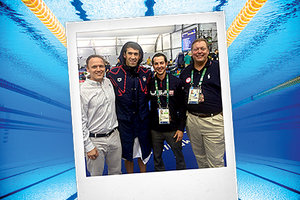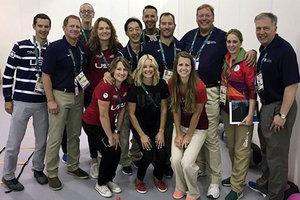It's probably old news to you that doctors of chiropractic play an increasingly prominent role in treating athletes, from youth sports participants to weekend warriors, to elite / professional competitors.
In this exclusive interview, Dr. Moreau shares his interest in sports medicine; his involvement with the Sports Medicine Team and experiences at this year's Rio Games; why his position as managing director benefits the entire chiropractic profession; and the first steps interested doctors of chiropractic can take to get involved in sports medicine at the local, professional and/or Olympic levels.
When did you become interested in sports medicine as a specialty of your chiropractic aspirations? While practicing in private practice decades ago in Iowa, it became clear to me that athletes, and their parents, were looking for a conservative care provider to help them with athletic injuries. What constitutes sports medicine as a specialty is broad and deep. I knew that additional education would be needed in order for me to provide the best care I could for my patients. This continuing journey to learn and earn certificates of additional qualifications with a sports medicine emphasis really provided a focus to my continued professional training over the past decades.
 Dr. Moreau (far right) behind the scenes with Michael Phelps (second from left) before his last swim of the 2016 Rio Games. From left: Kevin Rindal, DC, CCSP; Dustin Nabhan, DC, DACBSP.
My hunch was right: An already busy practice became much busier! Instead of trying a seminar here and there on different topics, the framework of a sports medicine-focused tract of learning provided a clear pathway to continued personal development. The old Socrates maxim is true: "The more I learn, the more I learn how little I know." It is great to start every day with an opportunity to improve and become a better doctor.
Dr. Moreau (far right) behind the scenes with Michael Phelps (second from left) before his last swim of the 2016 Rio Games. From left: Kevin Rindal, DC, CCSP; Dustin Nabhan, DC, DACBSP.
My hunch was right: An already busy practice became much busier! Instead of trying a seminar here and there on different topics, the framework of a sports medicine-focused tract of learning provided a clear pathway to continued personal development. The old Socrates maxim is true: "The more I learn, the more I learn how little I know." It is great to start every day with an opportunity to improve and become a better doctor.
Rising Through the USOC Sports Medicine Ranks
How did that interest progress to involvement with the USOC Sports Medicine Team and ultimately the position of managing director? I was fortunate the USOC was looking to diversify the staffing of the USOC sports medicine clinics. Michael Reed, DC, DACBSP, was already employed at the USOC and had opened the door for sports chiropractors to possibly be employed in the USOC clinics. The USOC was looking at for a manager of a USOC clinic and I applied.
It was an interesting experience to compete for the position with a very nice DPT. The practical case-based interview and follow-up interviews were much like what we see in a sports practice. I was fortunate to be selected to manage the clinic in Colorado Springs.
The athletes were happy with the services, which quickly grew to include another sports chiropractor, Dustin Nabhan, DC, DACBSP, and the addition of physical therapy to the existing certified athletic trainers. Eventually, I was promoted to oversee the three Olympic Training Center (OTC) clinics in Colorado Springs, Lake Placid and Chula Vista.
The success of the OTCs was really dependent upon the integration of the multidisciplinary teammates at each clinic to become one team focused on athlete outcomes. This success lead to promotions and the opportunity to develop and direct USOC strategy for the clinics, Games and National Medical Network.
The Rio Experience
What was an average day like for you during the Rio Olympics in terms of coordination of care, conditions managed, pre- and post-event care, etc.? The real planning for an Olympic / Paralympic Games starts four years in advance. There are site visits, relationship building, construction of medical emergency response plans, staff selection, ordering of equipment and supplies, as well as evaluations of the specific challenges of the location we are going to. It is a busy time for sure!
When the Games actually start, the planning sets up the medical team for success. The implementation of the previously mentioned integrated multidisciplinary model of care is unique to Team USA because of the diversity of the staff and the co-management approach by the providers. The days all blend together, starting at 0600 and continuing until the day's work is done. Each day presents with a new puzzle or challenge that is met by the team approach to care.
 The multidisciplinary Team USA 2016 Village Sports Medicine Staff. Front Row: Beth Morford, MT; Heather Linden, DPT; Hannah Gaveske, ATC. Second Row: David Weinstein, MD (Head Team Physician); Amy Murrin, MT; Steven Isono, MD; David Haight, MD; Bill Moreau, DC, DACBSP (Chief Medical Offi cer); Emma Painter (IOC); Mark Hutchinson, MD. Back Row: Dustin Nabhan (blue striped shirt), DC, DACBSP; Tony Poland, MT; Robert Gaisford, ATC.
Each person is carefully selected by their National Governing Body or the USOC to serve at a Games. When we can gather all this talent together as a cohesive team, I know that the tremendous talent of the clinicians will come together as one to serve the greatest athletes in the world.
The multidisciplinary Team USA 2016 Village Sports Medicine Staff. Front Row: Beth Morford, MT; Heather Linden, DPT; Hannah Gaveske, ATC. Second Row: David Weinstein, MD (Head Team Physician); Amy Murrin, MT; Steven Isono, MD; David Haight, MD; Bill Moreau, DC, DACBSP (Chief Medical Offi cer); Emma Painter (IOC); Mark Hutchinson, MD. Back Row: Dustin Nabhan (blue striped shirt), DC, DACBSP; Tony Poland, MT; Robert Gaisford, ATC.
Each person is carefully selected by their National Governing Body or the USOC to serve at a Games. When we can gather all this talent together as a cohesive team, I know that the tremendous talent of the clinicians will come together as one to serve the greatest athletes in the world.
What were some of the highlights (from a Sports Medicine Team perspective) at this year's Rio Olympics? The Rio 2016 Games provided opportunities to meet challenges around the Zika concern, water quality and other issues. All of the concerns were met by the staff through the planning.
One of my greatest personal experiences was to be able to go back in the warm-up area to say hello to Michael Phelps, the greatest Olympian of all time, before his last swim at the Rio Games.
On a daily basis, chiropractic care was provided to athletes from many sport disciplines by the sports chiropractors both at the Team USA clinics and at the IOC polyclinic. The athletes vote with their feet and chiropractic care was heavily used, along with other colleague's services, every day of the Games.
Chiropractic Year-Round
What about before and after the Olympics – athletes need chiropractic and other services leading up to the Olympic Trials and following the Olympics, as many begin the four-year journey toward the next Games. Many athletes utilize chiropractic care from the personal doctor of chiropractic in their home town or where they train; as well as at trials, world cups and other large competitions that occur every year all over the world. The athletes really know their bodies and they can recognize that the doctor of chiropractic can help them to achieve their best performance on a daily basis.
How do the U.S. athletes generally react / respond to chiropractic and other forms of non-allopathic care available to them? The care provided by the coalition of all types of providers is well-received by the athletes. The majority of all health encounters in Rio were provided by sports-certified doctors of chiropractic and their conservative care professional partners (ATC, PT and MT).
Building a Team
As a doctor of chiropractic, what do you consider your biggest reward – and biggest challenge – in heading the Sports Medicine Team? Life brings many rewards. For me, the opportunity to develop teams of providers who are focused on preventing injury and illness in athletes, as well as responding quickly should an injury or illness occur, is always amazing to me. When we work together, we can move a mountain to help an individual athlete be the best they can be on their day of competition.
From a professional / health care perspective, what's the importance of having a doctor of chiropractic as head of the Sports Medicine Team? What benefit has it already yielded the profession, in your opinion? My perspective of the benefits of having a sports certified doctor of chiropractic lead the USOC Sports Medicine Team is the value of having a leader who has an understanding of the depth and expected outcomes of conservative care measures, as well as the ability to identify and quickly implement other interventions depending on the patient's needs. It is really about building a team of great people with great sports medicine knowledge who want to work together to help an individual – without any ownership of who is the first to decide or treat.
When, not if, we build vertical integrated teams of health care providers to meet the challenges of delivering health care, the care the individual receives will be more effective and more efficient, without a doubt.
First Steps: Take Your Interest to the Next Level
Let's say a DC wanted to become involved with the Sports Medicine Team. What steps should they take to start that journey? What level of local involvement / qualifications (in sports chiropractic / sports medicine) do they need? When the doctor of chiropractic chooses to work outside the clinical setting, additional education and training in regards to topics like emergency management, concussion, pre-participation physicals and further managing extremity injuries become a must-have for their toolkit.
I would encourage any DC interested in sports to gain additional education and qualifications in chiropractic sports medicine. In the U.S., the DACBSP and CCSP are the recognized certificates of additional qualifications in chiropractic sports medicine that provide the education and credibility to engage at the highest levels of sport. Internationally, FICS has credentialing opportunities for those doctors who work outside the U.S. with the same goal in mind.
Regardless of your geographic location, there are opportunities for doctors of chiropractic to become further educated and engaged in helping athletes, teams and events.




